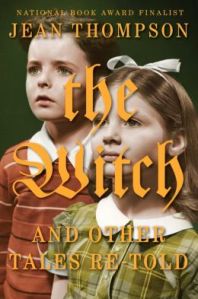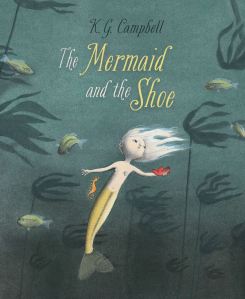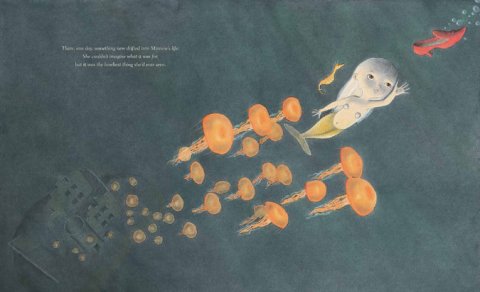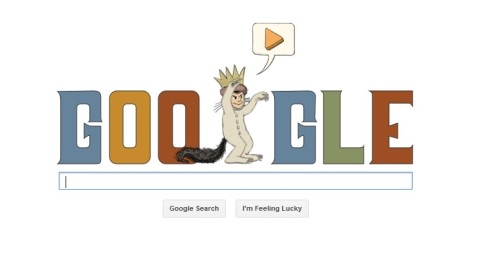Film Preview: Le Petit Prince
December 14, 2014 § Leave a comment
Normally one to rail against major revisions/additions to film adaptations of classic literature, I am completely charmed by this trailer for the new French animated film version of Antoine de Saint Exupery’s The Little Prince, and its added narrative of this little girl and her friendship with her oddball neighbor. If you’ve read the book, then you know that the narrator, the pilot, is addressing an unseen listener, and it’s conceivable that that listener might well look like the studious little girl given life in this new film. And by adding this framework, it seems to me that the filmmakers have captured the wonder of reading this book, either for the first time as a child, or as an adult lost in the pleasures of nostalgia. The shift in animation style between the “real” world and the story of the Little Prince is so lovely, portraying the story-within-a-story as something delicate and other-worldly. I can’t wait to see this!
Fairy Tale Books of 2014: A Gift Guide
December 6, 2014 § Leave a comment
Looking for just the right fairy tale book for all the readers on your holiday list? Here are some of the highlights of 2014, including books for both adults and younger readers. Enjoy!
Short Story Collections
 For the Realist You’re Trying to Convert:
For the Realist You’re Trying to Convert:
The Witch and Other Tales Retold, by Jean Thompson
Thompson is a master of exposing the wierdnesses of everyday life, in a manner that brings to mind Joyce Carol Oates at her vintage best. In this collection, she uses the framework and a few familiar tropes of beloved fairy tales and drops them into realistic tales of children surviving in a frightening foster home, teenagers acting out through sex, and young women tempted into strange, sudden marriages.
 For the Die-Hard Fabulist:
For the Die-Hard Fabulist:
How a Mother Weaned Her Girl From Fairy Tales, by Kate Bernheimer
Unlike Thompson, who uses familiar frameworks in updated settings in The Witch, Bernheimer is adept at crafting her own tales that are so odd and uncanny that they seem to be from another time. Frightening and fearless, Bernheimer’s imagination is at full force here — read these stories under a dim lamp at night, for optimal chills. « Read the rest of this entry »
Geoff Ryman’s WAS on The Slate Book Review
July 11, 2014 § 1 Comment
I have another review up this afternoon on Slate, of Geoff Ryman’s beautiful and raw 1992 novel WAS. WAS is inspired by The Wizard of Oz, but delves into dark territory such as abuse, AIDS, and misplaced nostalgia. I actually wrote the review over a year ago, and am happy to see it finally up. WAS is being reissued by Small Beer Press, a truly excellent fantasy press that also publishes the review Lady Churchill’s Rosebud Wristlet, and is helmed by Kelly Link and Gavin Grant. Check out the review, check out Small Beer, check out the book — it’s all good stuff. And thanks for reading!
“The Mermaid and the Shoe”: An Uncomplicated Fairy Tale
April 4, 2014 § Leave a comment
 K.G. Campbell’s delicately illustrated and completely charming picture book The Mermaid and the Shoe received several good reviews this week, and rightly so. The illustrations are beautiful while still engaging, and the story is simple and sweet. Minnow, the youngest daughter of a mer-king has yet to find her calling in life—her sisters tend to gardens, or train fish, but she is not good at any of these pursuits. But when she finds a strange object, she’s determined to discover its origins. Her journey takes her to the surface of the water, where she discovers a world in which mer-people don’t swim at all, but walk about on funny-looking appendages that they hide under shoes. If we were swimming in the seas of Hans Christian Andersen or Walt Disney, here would be the moment our mermaid spies her prince. But in K.G. Campbell’s refreshing book, Minnow swims quickly home, eager to tell her family all that she’s seen, and to find that her curiosity and storytelling are her calling.
K.G. Campbell’s delicately illustrated and completely charming picture book The Mermaid and the Shoe received several good reviews this week, and rightly so. The illustrations are beautiful while still engaging, and the story is simple and sweet. Minnow, the youngest daughter of a mer-king has yet to find her calling in life—her sisters tend to gardens, or train fish, but she is not good at any of these pursuits. But when she finds a strange object, she’s determined to discover its origins. Her journey takes her to the surface of the water, where she discovers a world in which mer-people don’t swim at all, but walk about on funny-looking appendages that they hide under shoes. If we were swimming in the seas of Hans Christian Andersen or Walt Disney, here would be the moment our mermaid spies her prince. But in K.G. Campbell’s refreshing book, Minnow swims quickly home, eager to tell her family all that she’s seen, and to find that her curiosity and storytelling are her calling.
The tale ends there—an uncomplicated story about a girl finding her confidence and her niche, eschewing any romance, sea-witches, or annoying foot pains. Yet the similarities between The Mermaid and the Shoe and Andersen’s The Little Mermaid (and Disney’s too, if we’re being honest here) are also what will have the adults choosing it scratching their heads. Isn’t there more? We know there is. Will this mermaid princess come to know what exists over the highest sand dune? She wouldn’t be the first — and we know from prior stories that what lies above the surface isn’t all pleasant. Parents might find this short tale easier to explain to children, but they’ll likely have trouble shaking the more complicated story that is its ancestor. And this comparison may paint The Mermaid and the Shoe in a somewhat boring light. Ah, well. It’s beautifully illustrated, and I can certainly appreciate an homage to storytelling, in any form. An endearing fable, The Mermaid and the Shoe is an escape for parents who aren’t up to explaining why any sane young mer-girl would give up her voice for a man. My hope would be that the child who has this story read to them will be inspired, as they grow, to discover more complex fairy tales.
Saving Mary Poppins
December 23, 2013 § 1 Comment
Mary Poppins needs a hand this winter, and the internet, thanks to all that is snarky and determined to spread truth, is here to save her. The indisputably expensive new Disney film Saving Mr. Banks, as you’re likely aware, claims to tell the true story behind the making of the indisputably delightful old Disney film, Mary Poppins, based on the novels of P.L. Travers. It pits prudish, harsh, and critical Travers (Emma Thompson) against fun-loving monomaniac Walt Disney (Tom Hanks) in the battle for the rights to produce the film. Disney woo-ed Travers for many years before securing her sign-off to make the film, and Saving Mr. Banks would have you believe that it’s because Walt finally got to the “core” of Travers’s psychosis in creating the character in the first place: daddy issues. It goes so far as to have Thompson beaming with pride at the film’s release, tears welling in her eyes.
But as you may also be aware, thanks to the diligent critics of the inter-webs, Thompson’s tears are a woeful misrepresentation of the true story that isn’t being told in the film: that Travers was devastated by the film. She fought Disney tooth and nail for five years, and you can bet that that fight was not just a charming sing-along by Richard and Robert Sherman and an escorted trip to Disneyland. It was surely much, much uglier. Walt Disney, to put it mildly, was not a nice man. He was a business man, one who insisted in his early films that only his name appear listed as animator, even when he had a team helping him. One who insisted on slapping his name in front of every title his studios put out, in case anyone forgot it. There would never be “P.L. Travers’ Mary Poppins” — there would only be his, and in the end, though Travers fought him, she lost. That’s what this film is about. « Read the rest of this entry »
My Grimm Project
August 29, 2013 § Leave a comment
It’s called “A Grimm Project,” and I hope you’ll click through and follow it.
“A Grimm Project” is a prompt-driven romp through all 242 tales in the 1987 edition of Jack Zipes’s The Complete Fairy Tales of the Brothers Grimm. I have been writing about other peoples’ work for a long time, and needed an impetus to create my own. So you all will need to hold me accountable, as I create a freewrite on this new blog in response to each fairy tale in the book.
You can help out, too! Each week over on A Grimm Project I’ll be posting on the next tale, in order, in the book, and then posting a short “response” to the tale. Some will be harder than others, but there will be NO SKIPPING. And if you feel inspired by a particular tale, please email me your freewrite in the email provided in the “About the Project” section, or post it in the comments. Each month, I’ll choose some favorites to be included in a special post. So please check it out, follow, and contribute!
You can already read my first entries, on the first tale in the Grimms’ collection, “The Frog King, or Iron Heinrich,” here.
Thanks,
Cate
Google Doodles for Maurice Sendak’s 85th
June 10, 2013 § 1 Comment
Maurice Sendak, author of Where the Wild Things Are, Outside Over There, My Brother’s Book and so many, many more, would have been 85 today. He died last May from complications from a stroke. In honor of his birthday, Google threw him a Doodle party. Make sure to check out the animation on Google’s home page today, but here are some screen shots to share the fun:
The Little Prince’s 70th Anniversary
April 7, 2013 § Leave a comment
 Yesterday marked the 70th anniversary of the publication of Antoine de Saint Exupery’s The Little Prince, one of the most recognizable, but also most thematically nuanced and melancholy, children’s books of the 20th Century. Published in 1943, the short novel draws on Exupery’s own experiences as a pilot. In the book, a pilot finds himself stranded, without fuel, in the Sahara desert. He meets the Little Prince, who is on his own adventure, having set off from his tiny home planet to learn more about life, love, and loss.
Yesterday marked the 70th anniversary of the publication of Antoine de Saint Exupery’s The Little Prince, one of the most recognizable, but also most thematically nuanced and melancholy, children’s books of the 20th Century. Published in 1943, the short novel draws on Exupery’s own experiences as a pilot. In the book, a pilot finds himself stranded, without fuel, in the Sahara desert. He meets the Little Prince, who is on his own adventure, having set off from his tiny home planet to learn more about life, love, and loss.
Although ostensibly a children’s book, The Little Prince explores, sometimes cynically, the difference between a child-like perception of the universe and adult relationships, and a more jaded “grown-up” point of view. The Prince learns about human trickery and pettiness as well as love on his journey, and though he does not discover that heartache is a purely “grown-up” emotion, having experienced it on his home planet through his relationship with his rose, he does discover that knowledge of the wider adult world does little to stave it off.
The most memorable quotes from The Little Prince spring from the Prince’s encounter with a Fox, whom he loves and tames, and thus feels an unbreakable connection to. And no one encapsulates the mix of child-like wonder and wise, desperate melancholy more than Gene Wilder as the Fox, in this live-action 1974 film adaptation.
Several special editions are in the works to mark the anniversary by Houghton Mifflin Harcourt. Learn more here.
The Grammar of Happiness: An Interview with Kate Bernheimer
March 29, 2013 § 3 Comments
Kate Bernheimer, editor of Fairy Tale Review and author of a trilogy of novels, The Complete Tales of Merry Gold, The Complete Tales of Lucy Gold, and The Complete Tales of Ketzia Gold, loves to talk fairy tales, even with a grueling schedule of panels and readings at the 2013 AWP Conference. Which is how I found myself lucky enough to be sitting next to her at a flyer-littered table in the AWP Bookfair as she graciously answered my questions about fairy tales, her past work, and her upcoming projects. Just that morning she was among the speakers at a unbelievably packed panel on fairy tale retellings (the other panelists were Jane Yolen, Kelly Link, Anjali Sachdeva and John Crowley), and so fairy tales and their prolific influence on all kinds of literature were on both our minds. In our conversation, we talked about the undefinable nature of fairy tales, writerly childhood nostalgia, the brutality of myths, and the power of the perfect final word.
 Kate is the author of the children’s books The Girl in the Castle Inside the Museum, The Lonely Book, and the forthcoming The Girl Who Wouldn’t Brush Her Hair (Random House Children’s Books/Schwartz & Wade Books, illustrated by Jake Parker) as well as the short story collection Horse, Flower, Bird (Coffee House Press, illustrated by Rikki Ducornet). Her second story collection, How a Mother Weaned Her Girl from Fairy Tales, is forthcoming in 2014 (also from Coffee House Press). She is the editor of the award-winning anthology My Mother She Killed Me, My Father He Ate Me (Penguin Non-Classics), as well as of Fairy Tale Review, which is now accepting submissions for The Emerald Issue, which will be inspired by The Wizard of Oz. She teaches at the University of Arizona in Tucson, where she lives with her husband, the writer Brent Hendricks (A Long Day at The End of the World) and their daughter.
Kate is the author of the children’s books The Girl in the Castle Inside the Museum, The Lonely Book, and the forthcoming The Girl Who Wouldn’t Brush Her Hair (Random House Children’s Books/Schwartz & Wade Books, illustrated by Jake Parker) as well as the short story collection Horse, Flower, Bird (Coffee House Press, illustrated by Rikki Ducornet). Her second story collection, How a Mother Weaned Her Girl from Fairy Tales, is forthcoming in 2014 (also from Coffee House Press). She is the editor of the award-winning anthology My Mother She Killed Me, My Father He Ate Me (Penguin Non-Classics), as well as of Fairy Tale Review, which is now accepting submissions for The Emerald Issue, which will be inspired by The Wizard of Oz. She teaches at the University of Arizona in Tucson, where she lives with her husband, the writer Brent Hendricks (A Long Day at The End of the World) and their daughter.
CF: So when I was coming up with questions for you, I came upon a theme, and that is how fairy tales overlap and blur the lines of genre. Mostly because my 1st question is about the Oz issue, and it occurred to me that, like Alice in Wonderland or Carlo Collodi’s Pinocchio, it’s not technically, by traditional definition, a fairy tale. It’s a novel with an author that we can point to and say, that’s where it comes from. And yet there are all of these examples in children’s lit that become, in the popular consciousness, fairy tales, and so it still seems to fit.
KB: To speak first to the “traditional definition” of fairy tales, it’s important to point out that many do have authors; authored works are not excluded from the body of work known as “fairy tales.” Pinocchio is a fairy tale. Even the Grimms are author/editors. The stories collected in their editions were painstakingly gathered, and edited by them in literary versions, that is “written.” Of course the stories don’t belong to the Grimms; fairy tales don’t belong to anyone. So that question of authorship and the question of the purity of the author and the individuality of the author comes into play in diverse ways in the fairy-tale tradition. My operating sensibility is to read through fairy-tale techniques and a fairy-tale affect. Reading this way, the entire Oz series is inarguably a fairy tale. Some scholars consider The Wizard of Oz series to be “the first American fairy tale”—I don’t think along those lines – looking for originating definitive versions; that’s a gesture that weirdly obliterates a more expansive sense of history. « Read the rest of this entry »




